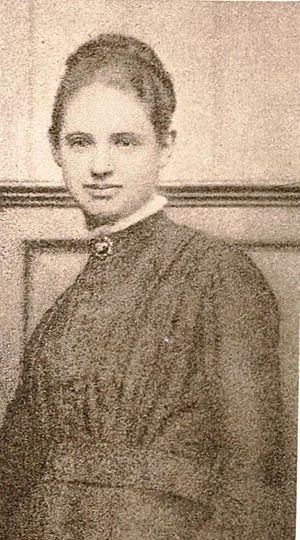Mary Elizabeth Coleridge facts for kids
Mary Elizabeth Coleridge (born September 23, 1861 – died August 25, 1907) was a talented British writer. She wrote many novels and poems, and also essays and reviews. She often used the pen name Anodos for her poetry. This name came from a book by George MacDonald. Other writers who inspired her were Richard Watson Dixon and Christina Rossetti. Even the Poet Laureate, Robert Bridges, said her poems were "wonderfully beautiful" but also a bit mysterious.
Her Life Story
Mary Coleridge was born in Hyde Park Square, London. Her father, Arthur Coleridge, was a lawyer and a very good amateur musician. He even helped start the London Bach Choir in 1875 with a famous singer named Jenny Lind. Their family friends included well-known people like Robert Browning, Alfred, Lord Tennyson, John Millais, and Fanny Kemble. Mary was also the great-grandniece of the famous poet Samuel Taylor Coleridge.
Mary was taught at home, mostly by a poet and teacher named W. J. Cory. She started writing poems when she was just a child. Even though her home was in London, she traveled a lot throughout her life. From 1895 to 1907, she taught at the London Working Women's College, helping women learn new skills.
She wrote five novels in total. Her first novel was The Seven Sleepers of Ephesus, published in 1893. This story was about a secret "Brotherhood" putting on a play in a German town. It was published under "M. E. Coleridge," which made some people think the author was a man!
Her other four novels were published by Edward Arnold. Her most famous novel was The King with Two Faces. This book was very popular and earned her a lot of money in 1897. It was about the French Revolution and the assassination of Gustavus III of Sweden.
Sadly, Mary Coleridge died in 1907 from problems after an appendicitis operation. She was on holiday in Harrogate at the time. She left behind many unfinished poems and a novel. Her poetry was first published under her real name in a book called Poems in 1908, after she had passed away. This book was very popular, selling many copies quickly. Henry Newbolt wrote in the book's introduction that Mary often used a pen name because she didn't want to "tarnish" the famous Coleridge name.
Later, in 1954, a full collection of her poems was published, which brought new interest to her work. More recently, her writings have been studied again and included in collections of Victorian women's poetry.
Music Inspired by Her Poems
Mary Coleridge's poems were often simple and had a touch of mystery and strong images. This made them perfect for composers to set to music. Hubert Parry and Charles Villiers Stanford, who were friends with Mary's father, often visited her family home.
Hubert Parry set seven of her poems to music for voice and piano in 1909. Many people believe he captured the feeling of her poems perfectly. Charles Villiers Stanford composed two sets of choral songs using her poems. The most famous of these is "The Blue Bird", based on Mary's poem originally called "L'Oiseau Bleu."
Other composers also set her poems to music, including John Ireland, Roger Quilter, Frank Bridge, and Cyril Rootham.
Her Published Books
- The Seven Sleepers of Ephesus (1893) – A novel about a mysterious group.
- The King with Two Faces (1897) – Her most famous novel, set during the French Revolution.
- The Lady on the Drawingroom Floor (1906) – Her last published novel.
- Poems (1908) – A collection of her poetry, published after her death.
- The Collected Poems of Mary Coleridge (1954) – A more complete collection of her poems.


